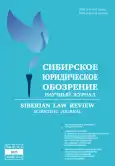The List of World Heritage in Danger as an Environmental Protection Instrument
- Авторлар: Kolobov R.Y.1
-
Мекемелер:
- A. E. Favorsky Irkutsk Institute of Chemistry of the Siberian Banch of the Russian Academy of Science Russian Federation
- Шығарылым: Том 22, № 2 (2025)
- Беттер: 215-226
- Бөлім: PUBLIC LEGAL (STATE LEGAL) SCIENCES
- ##submission.datePublished##: 07.07.2025
- URL: https://journal-vniispk.ru/2658-7602/article/view/340309
- DOI: https://doi.org/10.19073/2658-7602-2025-22-2-215-226
- EDN: https://elibrary.ru/CLKQVG
- ID: 340309
Дәйексөз келтіру
Толық мәтін
Аннотация
This article highlights the widespread use of listing as a tool in environmental protection, drawing attention to various types of lists established under international legal instruments. It provides statistical data on properties inscribed on the List of World Heritage in Danger and analyzes the historical context of its emergence. Particular attention is given to the pivotal role of the international campaign to rescue the Temple of Ramses II at Abu Simbel and the Sanctuary of Isis on Philae Island, which significantly contributed to the establishment of the global system for the protection of World Heritage. The legal foundations for inclusion on the List, as set out in the Convention Concerning the Protection of the World Cultural and Natural Heritage, are examined. The article underscores the critical importance of the Operational Guidelines for the Implementation of the Convention, offering a retrospective analysis of their provisions regarding the inscription of properties on the List of World Heritage in Danger. Special emphasis is placed on the decisions of a general nature adopted by the World Heritage Committee, which play a key role in shaping policy in this area, as well as on the technical and methodological documents developed by its advisory bodies. The evolution of the principle of state consent in the inscription process is explored, along with the circumstances that prompted a shift in approach. The article discusses instances where individual states strongly opposed the designation of sites on their territory as “in danger.” It also analyzes the practice of inscription based on the occurrence of specific conditions outlined by the World Heritage Committee, identifying the criteria used to assess the expected state of conservation of a property and the development of corrective action plans. Additionally, the article highlights the potential for financial institutions, including those in the banking sector, to suspend funding for high-risk projects that could lead to a site being placed on the List of World Heritage in Danger. Ultimately, the Author concludes that a realistic assessment of the List's potential is required, one that takes into account the actual state of the international regulatory framework governing World Heritage conservation.
Авторлар туралы
Roman Kolobov
A. E. Favorsky Irkutsk Institute of Chemistry of the Siberian Banch of the Russian Academy of ScienceRussian Federation
Хат алмасуға жауапты Автор.
Email: roman.kolobov@gmail.com
ORCID iD: 0000-0003-1488-7530
SPIN-код: 4471-2350
Leading Researcher at the A. E. Favorsky Irkutsk Institute of Chemistry of the Siberian Banch, Candidate of Legal Sciences, Associate Professor
Ресей, 1 Favorsky str., Irkutsk, 664033Әдебиет тізімі
- Hamman E., Geelen T. van, Akhtar-Khavari A. Governance Tools for the Conservation of Wetlands: the Role of the Montreux Record Under the Ramsar Convention. Marine and Freshwater Research. 2019;70(11):1493-1502. https://doi.org/10.1071/MF18483
- Hassan F. A. The Aswan High Dam and the International Rescue Nubia Campaign. The African Archaeological Review. 2007;24(3):73-94. https://doi.org/10.1007/s10437-007-9018-5
- Tamborrino R., Wendrich W. Cultural Heritage in Context: the Temples of Nubia, Digital Technologies and the Future of Conservation. Journal of the Institute of Conservation. 2017;40(2):168-182. https://doi.org/10.1080/19455224.2017.1321562
- Larkin C., Dumper M. UNESCO and Jerusalem: Constraints, Challenges and Opportunities. Jerusalem Quarterly. 2009;39:16-28.
- Pullan R. A. Conservation and the Development of National Parks in the Humid Tropics of Africa. Journal of Biogeography. 1988;15(1):171-183.
- Affolder N. Democratising or Demonising the World Heritage Convention? Victoria University of Wellington Law Review. 2007;38(2):341-361.
- Girmay M., Teshome E., Yoseph D. Exploring the Past and the Present: Examining Preservation, Management and Resistance practices in the Simien Mountains National Park, Ethiopia. Ethiopian Renaissance Journal of Social Sciences and Humanities. 2023;10(2):73-94. https://doi.org/10.4314/erjssh.v10i2.5
- Brown N. E., Liuzza C., Meskell L. The Politics of Peril: UNESCO’s List of World Heritage in Danger. Journal of Field Archaeology. 2019;44(5):287-303. https://doi.org/10.1080/00934690.2019.1600929
- Hølleland H., Hamman E., Phelps J. Naming, Shaming and Fire Alarms: The Compilation, Development and Use of the List of World Heritage in Danger. Transnational Environmental Law. 2019;8(1):35-57. https://doi.org/10.1017/S2047102518000225
- Lu F., Valdivia G., Wolford W. Social Dimensions of ‘Nature at Risk’ in the Galápagos Islands, Ecuador. Conservation & Society. 2013;11(1):83-95. https://doi.org/10.4103/0972-4923.110945
- Orlenok V.V., Krasnov Ye. V., Funtikov V. A., Chupahina G. N. Mineral Resources of the Kaliningrad Region. Mediterranean Journal of Social Sciences. 2015;6(6S7):252-256. https://doi.org/10.5901/mjss.2015.v6n6s7p252
- Gfeller A. E. Negotiating the Meaning of Global Heritage: ‘Cultural Landscapes’ in the UNESCO World Heritage Convention, 1972-92. Journal of Global History. 2013;8(3):483-503. https://doi.org/10.1017/S1740022813000387
- Perera-Valderrama S., Rosique-de la Cruz L. O., Caballero-Aragón H., Cerdeira-Estrada S., MartellDubois R., Ressl R. Mexico on Track to Protect 30% of Its Marine Area by 2030. Sustainability. 2023;15(19):14101. https://doi.org/10.3390/su151914101
- Longopa E. E. Legal Dimension on Protection of Outstanding Universal Value Properties in Tanzania: A Dilemma for Development Activities in the Selous Game Reserve. Eastern Africa Law Review. 2015;42(2):104-124.
Қосымша файлдар

Ескертпе
Supporting agencies: The research was conducted as part of the state assignment of the Russian Academy of Sciences, Project No. 125013001144-6











